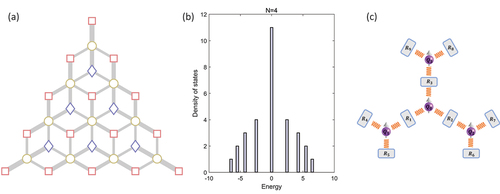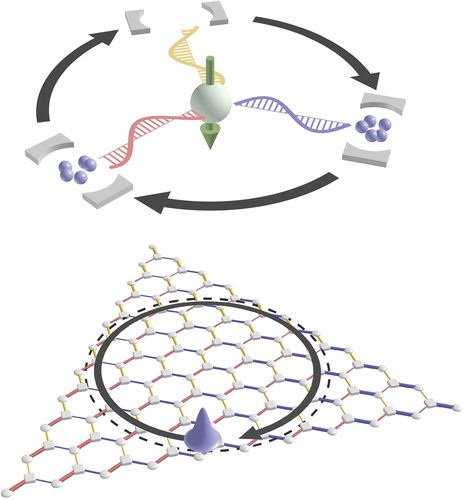Figures & data
Figure 1. The FSLs of d-mode JC model [Citation33]. (a) The FSL with d = 2 is a 1D SSH lattice (N = 5). (b) The FSL with d = 3 is a 2D honeycomb lattice (N = 5). (c) The FSL with d = 4 is a 3D diamond lattice (N = 3). The two sublattices are denoted by the balls and squares, and the numbers labelling the sites are the photon numbers in the d modes. The coupling strengths are proportional to the widths of lines connecting neighboring sites. Here we set the vacuum coupling strengths of all d modes equal, i.e.
.
![Figure 1. The FSLs of d-mode JC model [Citation33]. (a) The FSL with d = 2 is a 1D SSH lattice (N = 5). (b) The FSL with d = 3 is a 2D honeycomb lattice (N = 5). (c) The FSL with d = 4 is a 3D diamond lattice (N = 3). The two sublattices are denoted by the balls and squares, and the numbers n1n2…nd labelling the sites are the photon numbers in the d modes. The coupling strengths are proportional to the widths of lines connecting neighboring sites. Here we set the vacuum coupling strengths of all d modes equal, i.e. gj=g.](/cms/asset/27823939-63d0-4ea8-9b59-30d6a367477b/tapx_a_2325611_f0001_oc.jpg)
Figure 2. The topological defect transfer in 1D FSLs. (a) The probability distribution of topological defect states (solid lines) localized at the topological edge (dashed lines). The vacuum coupling strengths are and
[Citation33]. (b) Transport fidelity as a function of the total transport duration T. The transfer can be accelerated in the non-adiabatic regime (marked by the empty circles) [Citation40]. (c) Robustness of the topological transport with different noise strength
[Citation40]. (d) False-color circuit image of the experimental device [Citation34]. The main elements of the circuit consist of the central qubit Q0 (green line) and three resonators
as twisting lines in cyan, red and yellow, respectively. The resonators and the qubit are coupled via couplers (two-circle elements in blue), which are used for tuning the coupling strengths. The purple lines indicate the ancilla qubit used for preparation and readout of the resonators. Inset: schematic of the main elements a central qubit Q0 (green) coupled to three resonators R1 (cyan), R2 (red) and R3 (yellow). (e) Experimental observation of the defect state transport for an initial state
. The photons are transferred from R2 to R1 at around t = 600 ns [Citation34].
![Figure 2. The topological defect transfer in 1D FSLs. (a) The probability distribution of topological defect states (solid lines) localized at the topological edge (dashed lines). The vacuum coupling strengths are g1=g0sinθ and g2=g0cosθ [Citation33]. (b) Transport fidelity as a function of the total transport duration T. The transfer can be accelerated in the non-adiabatic regime (marked by the empty circles) [Citation40]. (c) Robustness of the topological transport with different noise strength δ [Citation40]. (d) False-color circuit image of the experimental device [Citation34]. The main elements of the circuit consist of the central qubit Q0 (green line) and three resonators R1,R2,R3 as twisting lines in cyan, red and yellow, respectively. The resonators and the qubit are coupled via couplers (two-circle elements in blue), which are used for tuning the coupling strengths. The purple lines indicate the ancilla qubit used for preparation and readout of the resonators. Inset: schematic of the main elements a central qubit Q0 (green) coupled to three resonators R1 (cyan), R2 (red) and R3 (yellow). (e) Experimental observation of the defect state transport for an initial state |↓,0,5⟩. The photons are transferred from R2 to R1 at around t = 600 ns [Citation34].](/cms/asset/067a0531-290d-4ed5-9677-a3c91fe29186/tapx_a_2325611_f0002_oc.jpg)
Figure 3. The PMFs, pseudo-Landau levels and geometric phases. (a) The distribution of the strain-induced PMF, . The PMF is induced by the inhomogeneous hopping strengths inside the incircle of the lattice. The Dirac points are shifted as if being coupled to a vector potential [Citation33]. (b) Experimental observation of the pseudo-Landau levels. The upper panel shows the evolution of the excited state population. Green dots and black line represent the experimental data and numerical simulation. The frequency components are shown in the bottom left panel by performing the fast Fourier transform of the Rabi oscillation, which agrees with the theoretically predicted
-energy spectra in the bottom right panel [Citation34]. (c) The equivalence between the Berry phase of the pseudo-spin and the AB phase induced by the PMF in lattice [Citation47].
![Figure 3. The PMFs, pseudo-Landau levels and geometric phases. (a) The distribution of the strain-induced PMF, B(r)/B0+. The PMF is induced by the inhomogeneous hopping strengths inside the incircle of the lattice. The Dirac points are shifted as if being coupled to a vector potential [Citation33]. (b) Experimental observation of the pseudo-Landau levels. The upper panel shows the evolution of the excited state population. Green dots and black line represent the experimental data and numerical simulation. The frequency components are shown in the bottom left panel by performing the fast Fourier transform of the Rabi oscillation, which agrees with the theoretically predicted n-energy spectra in the bottom right panel [Citation34]. (c) The equivalence between the Berry phase of the pseudo-spin and the AB phase induced by the PMF in lattice [Citation47].](/cms/asset/489ca01f-1470-4f28-868d-eae08e9cdb2d/tapx_a_2325611_f0003_oc.jpg)
Figure 4. The valley Hall effect in 2D FSLs [Citation34]. (a) The evolution of the wavefucntion distribution in the FSL. The directions of the trajectories are perpendicular to the effective electric fields (arrow) and opposite on two valleys, due to the opposite signs of the PMF. The size of the dots indicates the population of the states. (b) The evolution of the averaged photon numbers in resonators for the coherent initial state (
). Photons are exchanged between resonators without exciting the qubit. (c) The measured Wigner functions of the three resonator states at time t = 100 and 290 ns, showing opposite chirality of the states in the two valleys.
![Figure 4. The valley Hall effect in 2D FSLs [Citation34]. (a) The evolution of the wavefucntion distribution in the FSL. The directions of the trajectories are perpendicular to the effective electric fields (arrow) and opposite on two valleys, due to the opposite signs of the PMF. The size of the dots indicates the population of the states. (b) The evolution of the averaged photon numbers in resonators for the coherent initial state |↓,α,0,−α⟩ (α≈1.8). Photons are exchanged between resonators without exciting the qubit. (c) The measured Wigner functions of the three resonator states at time t = 100 and 290 ns, showing opposite chirality of the states in the two valleys.](/cms/asset/5870cee2-19cc-4ee2-9322-ca8f275eabad/tapx_a_2325611_f0004_oc.jpg)
Figure 5. The Haldane model in FSLs. (a) The spectrum of the FSL Haldane hamiltonian . The color depicts the spin polarization
. The edge modes connect the upper and lower bands [Citation33]. (b) The evolution of the averaged photon number in resonators shows the chiral edge current, which is realized by periodically modulating the coupling strengths [Citation34,Citation48]. (c) The phase diagram of the generalized Haldane FSL with hamiltonian
. The color depicts the value of the topological marker near the lattice center [Citation33].
![Figure 5. The Haldane model in FSLs. (a) The spectrum of the FSL Haldane hamiltonian HH. The color depicts the spin polarization ⟨σz⟩. The edge modes connect the upper and lower bands [Citation33]. (b) The evolution of the averaged photon number in resonators shows the chiral edge current, which is realized by periodically modulating the coupling strengths [Citation34,Citation48]. (c) The phase diagram of the generalized Haldane FSL with hamiltonian HH′. The color depicts the value of the topological marker near the lattice center [Citation33].](/cms/asset/8d9ae139-cab8-4df8-95d4-a1f1462b9b62/tapx_a_2325611_f0005_oc.jpg)
Figure 6. Generating NOON states through the quantum transistor. (a) The state evolution in the FSL with the spin-orbit coupling hamiltonian. The inset shows sublattice-dependent phases of the NNN hoppings. The blue (red) dots represent the probability amplitude on the (
) sublattice.
is the time to complete photon exchange between cavities [Citation48]. (b) Schematic configuration of the quantum transistor. The cavity 1 is the input and cavity 2 and 3 are the outputs. The output state is controlled by the quantum state of the qubit [Citation49]. (c) The quantum circuit scheme for preparing NOON states with N = 10. Each line represents an inseparable state. nj is the photon number of the jth cavity. The block
denotes the
Rabi rotation between the jth cavity and the qubit.
denotes the state evolution under the effective Haldane term for time
[Citation48].
![Figure 6. Generating NOON states through the quantum transistor. (a) The state evolution in the FSL with the spin-orbit coupling hamiltonian. The inset shows sublattice-dependent phases of the NNN hoppings. The blue (red) dots represent the probability amplitude on the ↑ (↓) sublattice. T is the time to complete photon exchange between cavities [Citation48]. (b) Schematic configuration of the quantum transistor. The cavity 1 is the input and cavity 2 and 3 are the outputs. The output state is controlled by the quantum state of the qubit [Citation49]. (c) The quantum circuit scheme for preparing NOON states with N = 10. Each line represents an inseparable state. nj is the photon number of the jth cavity. The block θj denotes the θ Rabi rotation between the jth cavity and the qubit. Hsodenotes the state evolution under the effective Haldane term for time T [Citation48].](/cms/asset/b40a3859-70e1-4cc8-9a76-f4c352413edf/tapx_a_2325611_f0006_oc.jpg)
Figure 7. Extensions of the multi-mode JC model. (a) Fock-state lattice of JC models with three cavities being coupled to two atoms. The three types of sites correspond to (squares),
(circles) and
(diamonds). The total excitation number N = 4. (b) The energy spectrum of the FSL in (a). Compared to the FSL with only one atom, the zero-energy level has a much higher degeneracy, containing a flat band due to the dice lattice configuration. (c) Schematic design of an atom-resonator lattice with a high dimensional FSL for unexplored topological states.


